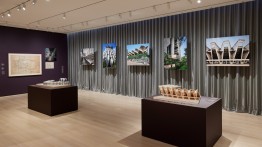Students Model South Asian Architecture at MoMA
POSTED ON: August 29, 2022

Installation view, The Project of Independence: Architectures of Decolonization in South Asia, 1947–1985, The Museum of Modern Art, New York. Photo: David Almeida. Student contributors: Risako Arcari, Taesha Aurora, Jesse Bassett, Javier Blancas, Bo Cai, Yunru (Daisy) Chen, Thomas Choi, Junmin Chung, Tilok Costa, Claudia D’Auria, Samuel Dobens, Isaac Islas-Cox, Xinyi Guo, Jiwon Heo, Mudong Jung,Sanjana Lahiri, Maks Mamak, Jyhun Park, Fredrick (Didi) Rapp, Karim Sabry, Maren Speyer, Tracy Tan, Wei Hong Xie, and Brandy Vazquez.
Students from The Irwin S. Chanin School of Architecture recently showed off their skills and expertise at the Museum of Modern Art (MoMA). The occasion was a special collaboration between The Cooper Union and MoMA as part of the revelatory exhibition The Project of Independence, Architectures of Decolonization in South Asia, 1947–1985.
The model-building enterprise, a follow-up to a similar collaboration in 2018 for MoMA’s Toward a Concrete Utopia exhibition, was part of a hybrid course on modern architecture in South Asia taught by James Lowder, assistant professor of architecture, in the spring of 2020. Along with the academic component of the class, students built six models of the buildings under study, which had been chosen by the MoMA curatorial team. Those models were on display at MoMA as part of the Project of Independence exhibition, which ran through July 2, 2022.
In the post-war period in South Asia, nations worked to create new identities distinct from their colonial pasts. In architectural terms, this meant finding a fresh architectural language and a different way of embracing modernism. “Modern architecture was a global phenomenon that at once could be said to have some colonizing qualities, as it is a cultural product of Western Europe but was also seen as a liberating force,” Lowder explains. “Part of the task for these new democratic governments of the region was to find an architectural expression that matched their social, political, and cultural ambitions.”
The models themselves, made by hand and constructed of wood, organically mirror the use of craft and natural materials that architects of the region adopted to recast modernist motifs in terms that honored histories and traditions. “I think the students got a lot from studying the buildings and discussing them with the curators to see what the important aspects were for the models to show,” says Lowder. “Along with that, the exposure to the inner workings and thought processes that go into an exhibition at a world-class museum is such a special experience.”
Andrew Song, a fourth-year student in the architectural program, notes that consulting with the MoMA curators was a unique opportunity and that teamwork among the students was vital. “The scale of the project demanded a collaborative process. Given its size and complexity, it could not have been a single person’s endeavor,” Andrew says. “One example I recall was the construction of the ground that one building rested on—that alone took nearly a month of work. The necessity for the team to communicate fluidly and work in unison was essential.”
“Working once again with the architecture students and faculty of The Cooper Union has been an immensely gratifying experience for the MoMA curatorial team. Cooper students are widely known to be extremely adept model-makers and for continuing a long legacy of the school on visual representation and material craftsmanship,” says Evangelos Kotsioris, assistant curator in the Department of Architecture and Design at MoMA. “In most instances, the documentation available was scant. The whole operation often resembled a forensic analysis and assembly of evidence in order to arrive at the exquisitely detailed models that we are thrilled to finally be able to share with MoMA’s wide audiences.”
A new campus exhibition, on view through September 11, showcases six of the student-made architectural models from The Project of Independence: Architectures of Decolonization in South Asia, 1947–1985. The exhibition is on view in the Third Floor Lobby of the Foundation Building and is open to students, faculty, and staff.




